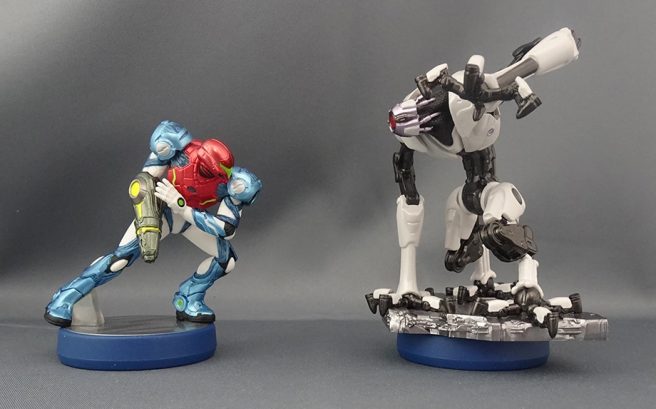Nintendo developer talks CG and amiibo work for Metroid Dread
In a post on Nintendo’s recruitment website, developer Uenaka Minoru shared insight into his work on Metroid Dread, including CG and amiibo. He’s been with the planning and production department since 2019.
Minoru’s post goes into working with MercurySteam and how the “finest details” needed to be considered since CG was used on Nintendo’s website, the boxart, and more. Working on E.M.M.I. was probably the biggest aspect of the project since it required “a sense of realism that required not just cooperation from the series development team, but also cooperation with other companies to get the fine details properly finished and as convincing as possible.” As for the amiibo, he wanted to create two poses so that it would look like Samus and the E.M.M.I. were squaring off.
Here’s our full translation:
Creating detail with 3DCG
I majored in oil painting at an arts college before moving on to graduate school, where I mainly focused on an area called ‘artistic anatomy,’ and I studied the structure of human and animal bodies. I thought that the knowledge I obtained then could be used in a game company making characters, and I started working with 3D computer graphics (3DCG) modeling.
Then in my second year since joining the company, I worked in collaboration with a Spanish company on a title called Metroid Dread. The character design was mostly done by the team in Spain. For making illustrations to be used on the packaging and for advertisements, I received game data and sketches from the development company to create 3DCG, and needed to brush-up even the finest details. Why was it so necessary to brush up even the finest details? Well, the increasingly realistic 3DCG artwork would initially be used on the Nintendo website, the game packaging, and media, but would also be used elsewhere such as for oversized adverts at train stations. For that it was necessary to create images that could still be appreciated, no matter how much they were enlarged or stretched.
The process of creation is like a relay race
The models that I was put in charge of were the protagonist Samus’ weapons, a boss of the Chozo species, and then a speciality of this project, Samus’ relentless pursuers, the E.M.M.I. robots. This project had a sense of realism that required not just cooperation from the series development team, but also cooperation with other companies to get the fine details properly finished and as convincing as possible. Since the E.M.M.I. were robots, we wanted to express the characteristics of ‘mecha’ right down to the smallest details. However, we had to think about how far we could add details, especially to avoid ruining the impression of the E.M.M.I. by working on things that were not present in game models.
For that I looked at lots of industrial products to see how a machine-like body for a character can be constructed, at times I even redrew plans from scratch. At the end I also discussed with the illustrators and game developers to ensure my interpretation of the characters didn’t differ from theirs, and I could confirm exactly what needed to be done. We used various approaches and understood it was important to use appropriate techniques when modeling the characters.
This job really does proceed like a relay race. First we receive data from the development company, then as a 3DCG modeler I add details, and then illustrators adjust the pose and lighting, as well as adding things such as backgrounds, before we can finally deliver something to the eyes of the customer.
This time once the 3DCG was finished I passed the baton to the illustrators, but that wasn’t the end of it. There were amiibo of Samus and E.M.M.I. being made and I was also involved in their creation. When making them we wanted them to look like they were squaring off when standing together so that was considered when thinking about how to pose them, as we wanted fans to be happy seeing them side-by-side. Doing it was difficult, but I think I was able to create poses that were both dynamic and natural, using the knowledge I had gained during my studies on the human body. I was very happy to not only be involved in CG, but also a tangible product that one can actually hold. I was very proud of being able to deliver such a product to the fans.
Metroid Dread is available on Switch now.
Translation provided by Simon Griffin and SatsumaFS on behalf of Nintendo Everything.
